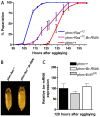Dynamic feedback circuits function as a switch for shaping a maturation-inducing steroid pulse in Drosophila
- PMID: 24173800
- PMCID: PMC3833430
- DOI: 10.1242/dev.099739
Dynamic feedback circuits function as a switch for shaping a maturation-inducing steroid pulse in Drosophila
Abstract
Steroid hormones trigger the onset of sexual maturation in animals by initiating genetic response programs that are determined by steroid pulse frequency, amplitude and duration. Although steroid pulses coordinate growth and timing of maturation during development, the mechanisms generating these pulses are not known. Here we show that the ecdysone steroid pulse that drives the juvenile-adult transition in Drosophila is determined by feedback circuits in the prothoracic gland (PG), the major steroid-producing tissue of insect larvae. These circuits coordinate the activation and repression of hormone synthesis, the two key parameters determining pulse shape (amplitude and duration). We show that ecdysone has a positive-feedback effect on the PG, rapidly amplifying its own synthesis to trigger pupariation as the onset of maturation. During the prepupal stage, a negative-feedback signal ensures the decline in ecdysone levels required to produce a temporal steroid pulse that drives developmental progression to adulthood. The feedback circuits rely on a developmental switch in the expression of Broad isoforms that transcriptionally activate or silence components in the ecdysone biosynthetic pathway. Remarkably, our study shows that the same well-defined genetic program that stimulates a systemic downstream response to ecdysone is also utilized upstream to set the duration and amplitude of the ecdysone pulse. Activation of this switch-like mechanism ensures a rapid, self-limiting PG response that functions in producing steroid oscillations that can guide the decision to terminate growth and promote maturation.
Keywords: Developmental timing; Ecdysone; Neuropeptide; Prothoracic gland; Prothoracicotropic hormone.
Figures






References
-
- Andres A. J., Fletcher J. C., Karim F. D., Thummel C. S. (1993). Molecular analysis of the initiation of insect metamorphosis: a comparative study of Drosophila ecdysteroid-regulated transcription. Dev. Biol. 160, 388–404 - PubMed
-
- Ashburner M., Chihara C., Meltzer P., Richards G. (1974). Temporal control of puffing activity in polytene chromosomes. Cold Spring Harb. Symp. Quant. Biol. 38, 655–662 - PubMed
-
- Barolo S., Carver L. A., Posakony J. W. (2000). GFP and beta-galactosidase transformation vectors for promoter/enhancer analysis in Drosophila. Biotechniques 29, 726, 728, 730, 732 - PubMed
-
- Bayer C. A., Holley B., Fristrom J. W. (1996). A switch in broad-complex zinc-finger isoform expression is regulated posttranscriptionally during the metamorphosis of Drosophila imaginal discs. Dev. Biol. 177, 1–14 - PubMed
-
- Beydon P., Lafont R. (1983). Feedback inhibition of ecdysone production by 20-hydroxyecdysone in Pieris brassicae pupae. J. Insect Physiol. 29, 529–533
Publication types
MeSH terms
Substances
Grants and funding
LinkOut - more resources
Full Text Sources
Other Literature Sources
Molecular Biology Databases

